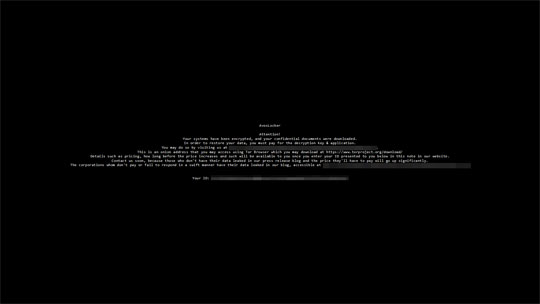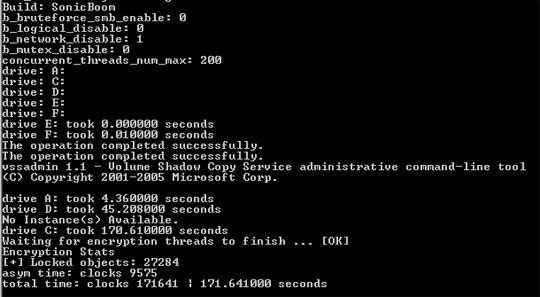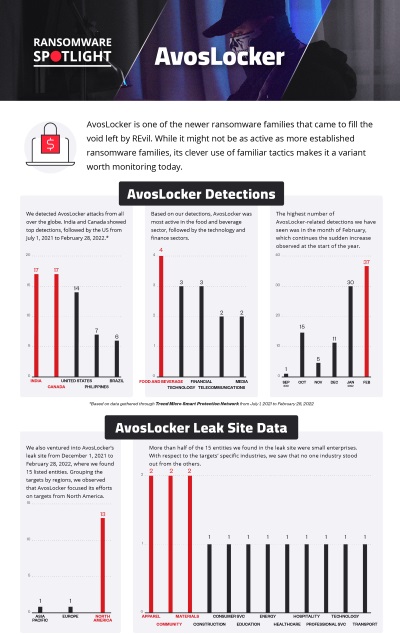Ransom.Win32.AVOSLOCKER.SMYXBLNT
Win32/AvosLocker.MBK!MTB (Microsoft), Win32/Filecoder.AvosLocker.A (Bitdefender)
Windows


Threat Type: Ransomware
Destructiveness: No
Encrypted:
In the wild: Yes
OVERVIEW
This Ransomware arrives on a system as a file dropped by other malware or as a file downloaded unknowingly by users when visiting malicious sites.
It drops files as ransom note. It avoids encrypting files with the following file extensions.
TECHNICAL DETAILS
Arrival Details
This Ransomware arrives on a system as a file dropped by other malware or as a file downloaded unknowingly by users when visiting malicious sites.
Installation
This Ransomware drops the following files:
- %User Temp%\{Random Digits}.png - Wallpaper
(Note: %User Temp% is the current user's Temp folder, which is usually C:\Documents and Settings\{user name}\Local Settings\Temp on Windows 2000(32-bit), XP, and Server 2003(32-bit), or C:\Users\{user name}\AppData\Local\Temp on Windows Vista, 7, 8, 8.1, 2008(64-bit), 2012(64-bit) and 10(64-bit).)
It adds the following processes:
- cmd /c wmic shadowcopy delete /nointeractive
- cmd /c vssadmin.exe Delete Shadows /All /Quiet
- cmd /c bcdedit /set {default} recoveryenabled No
- cmd /c bcdedit /set {default} bootstatuspolicy ignoreallfailures
- cmd /c powershell -command "Get-EventLog -LogName * | ForEach { Clear-EventLog $_.Log }"
- powershell -Command "$a = [System.IO.File]::ReadAllText(\"D:\GET_YOUR_FILES_BACK.txt\");Add-Type -AssemblyName System.Drawing;$filename = \"$env:temp\$(Get-Random).png\";$bmp = new-object System.Drawing.Bitmap 1920,1080;$font = new-object System.Drawing.Font Consolas,10;$brushBg = [System.Drawing.Brushes]::Black;$brushFg = [System.Drawing.Brushes]::White;$format = [System.Drawing.StringFormat]::GenericDefault;$format.Alignment = [System.Drawing.StringAlignment]::Center;$format.LineAlignment = [System.Drawing.StringAlignment]::Center;$graphics = [System.Drawing.Graphics]::FromImage($bmp);$graphics.FillRectangle($brushBg,0,0,$bmp.Width,$bmp.Height);$graphics.DrawString($a,$font,$brushFg,[System.Drawing.RectangleF]::FromLTRB(0, 0, 1920, 1080),$format);$graphics.Dispose();$bmp.Save($filename);reg add \"HKEY_CURRENT_USER\Control Panel\Desktop\" /v Wallpaper /t REG_SZ /d $filename /f;Start-Sleep 1;rundll32.exe user32.dll, UpdatePerUserSystemParameters, 0, $false;"
- %System%\reg.exe add "HKEY_CURRENT_USER\Control Panel\Desktop" /v Wallpaper /t REG_SZ /d C:\Users\DYITUS~1\AppData\Local\Temp\1544981028.png /f
- %System%\rundll32.exe user32.dll UpdatePerUserSystemParameters 0 False
(Note: %System% is the Windows system folder, where it usually is C:\Windows\System32 on all Windows operating system versions.)
It adds the following mutexes to ensure that only one of its copies runs at any one time:
- Zheic0WaWie6zeiy -> Only if "--nomutex" is not used
Other System Modifications
This Ransomware changes the desktop wallpaper by modifying the following registry entries:
HKEY_CURRENT_USER\Control Panel\Desktop
Wallpaper = %User Temp%\{Random Digits}.png
It sets the system's desktop wallpaper to the following image:
- %User Temp%\{Random Digits}.png

Process Termination
This Ransomware terminates the following processes if found running in the affected system's memory:
- encsvc
- thebat
- mydesktopqos
- xfssvccon
- firefox
- infopath
- winword
- steam
- synctime
- notepad
- ocomm
- onenote
- mspub
- thunderbird
- agntsvc
- sql
- excel
- powerpnt
- outlook
- wordpad
- dbeng50
- isqlplussvc
- sqbcoreservice
- oracle
- ocautoupds
- dbsnmp
- msaccess
- tbirdconfig
- ocssd
- mydesktopservice
- visio
Other Details
This Ransomware does the following:
- This Ransomware displays its encryption progress in console.

- It encrypts files found in the following drives:
- Fixed Drives
- Removable Drives
- Network Share Drives
- It checks if the file it tries to encrypt is being ran by another process
- If the file is currently being used by another process, the ransomware kills the process and proceeds with encryption
It accepts the following parameters:
- -p, --path [Path to Encrypt] →
- -b, --brutesmb → Bruteforce SMB for logical drives
- --nomutex → Disable mutex / ignore other instances
- -l, --disabledrives → Disable logical drives enumeration
- -n, --enablesmb → Enable SMB enumeration
- -t, --threads [No of Threads] → Max threads for encryption (default:200)
- -h, --help → Print usage
Ransomware Routine
This Ransomware avoids encrypting files with the following strings in their file name:
- autorun.inf
- boot.ini
- bootfont.bin
- bootsect.bak
- config.msi
- desktop.ini
- iconcache.db
- ntldr
- ntuser.dat
- ntuser.dat.log
- ntuser.ini
- thumbs.db
- Thumbs.db
It avoids encrypting files with the following strings in their file path:
- All Users
- AppData
- boot
- bootmgr
- Games
- Intel
- Microsoft. [Directory name starts with Microsoft.]
- Program Files
- ProgramData
- Public
- Sophos
- System Volume Information
- Windows
- Windows.old
- WinNT
It appends the following extension to the file name of the encrypted files:
- .avos2
It drops the following file(s) as ransom note:
- %Desktop%\GET_YOUR_FILES_BACK.txt
- {Encrypted Directory}\GET_YOUR_FILES_BACK.txt

It avoids encrypting files with the following file extensions:
- avos
- avoslinux
- avos2
- avos2j
- themepack
- nls
- diagpkg
- msi
- lnk
- exe
- cab
- scr
- bat
- drv
- rtp
- msp
- prf
- msc
- ico
- key
- ocx
- diagcab
- diagcfg
- pdb
- wpx
- hlp
- icns
- rom
- dll
- msstyles
- mod
- ps1
- ics
- hta
- bin
- cmd
- ani
- 386
- lock
- cur
- idx
- sys
- com
- deskthemepack
- shs
- ldf
- theme
- mpa
- nomedia
- spl
- cpl
- adv
- icl
- msu
SOLUTION
Step 1
Trend Micro Predictive Machine Learning detects and blocks malware at the first sign of its existence, before it executes on your system. When enabled, your Trend Micro product detects this malware under the following machine learning name:
-
Ransom.Win32.TRX.XXPE50FFF053
Step 2
Before doing any scans, Windows 7, Windows 8, Windows 8.1, and Windows 10 users must disable System Restore to allow full scanning of their computers.
Step 3
Note that not all files, folders, and registry keys and entries are installed on your computer during this malware's/spyware's/grayware's execution. This may be due to incomplete installation or other operating system conditions. If you do not find the same files/folders/registry information, please proceed to the next step.
Step 4
Identify and terminate files detected as Ransom.Win32.AVOSLOCKER.SMYXBLNT
- Windows Task Manager may not display all running processes. In this case, please use a third-party process viewer, preferably Process Explorer, to terminate the malware/grayware/spyware file. You may download the said tool here.
- If the detected file is displayed in either Windows Task Manager or Process Explorer but you cannot delete it, restart your computer in safe mode. To do this, refer to this link for the complete steps.
- If the detected file is not displayed in either Windows Task Manager or Process Explorer, continue doing the next steps.
Step 5
Search and delete this file
- %User Temp%\{Random Digits}.png
Step 6
Scan your computer with your Trend Micro product to delete files detected as Ransom.Win32.AVOSLOCKER.SMYXBLNT. If the detected files have already been cleaned, deleted, or quarantined by your Trend Micro product, no further step is required. You may opt to simply delete the quarantined files. Please check the following Trend Micro Support pages for more information:
Step 7
Reset your Desktop properties
Step 8
Restore encrypted files from backup.
Did this description help? Tell us how we did.


